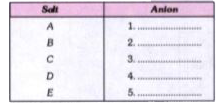Give reason for the following:
(i). Silver ornament gets tarnished when exposed to atmosphere for a long time.
(ii) Silver nitrate solution is kept in dark coloured bottles.
(iii). Why does AgNO3 produce a black stain on the skin.
(i). Ag reacts slowly with trace of H2S in air forming a black layer of Ag2S on surface.
2Ag+H2S→Ag2SBlack+H2
(ii). AgNO3 is photosensitive, It decomposes in presence of light. To prevent its decomposition, it is kept in coloured bottles as these do not permit light to pass through.
(iii). In the presence of organic matter and light AgNO3, Decomposes to give a black stain of metallic silver.
2AgNO3→2Ag↓+2NO2+O2
Topper's Solved these Questions
- BOOK - CENGAGE CHEMISTRY ENGLISHCHAPTER - D AND F BLOCK ELEMENTSEXERCISE - Ex 6.2 Subjective (Compound Of Hg:)3videos
D AND F BLOCK ELEMENTS
- BOOK - CENGAGE CHEMISTRY ENGLISHCHAPTER - D AND F BLOCK ELEMENTSEXERCISE - Exercises Linked Comprehension31videos
D AND F BLOCK ELEMENTS
- BOOK - CENGAGE CHEMISTRY ENGLISHCHAPTER - D AND F BLOCK ELEMENTSEXERCISE - Ex 6.2 Subjective (Compound Of Zn:)1videos
D AND F BLOCK ELEMENTS
- BOOK - CENGAGE CHEMISTRY ENGLISHCHAPTER - COORDINATION COMPOUNDSEXERCISE - Archives Subjective18videos
COORDINATION COMPOUNDS
- BOOK - CENGAGE CHEMISTRY ENGLISHCHAPTER - ELECTROCHEMISTRYEXERCISE - Archieves Subjective35videos
ELECTROCHEMISTRY
Similar Questions
Give reason for the following:
Silver nitrate solution is kept in coloured bottles.View SolutionGive reason for the following observations :
(i) When Silver nitrate solution is added to Potassium iodide soltuion , a negatively charge colloidal solution is formed.
(ii) Finely divided substance is more effective as an adsorbent.
(iii) Lyophilic colloid are also called reversible sols.View Solution(a) Explain why cleavage of phenyl ethers with HBr always produces phenol and alkyl bromides and not bromobenzene and alkanols.
(b) Give reasons for the following:
(i) The dipole moment of diethyl ether (1.18D) is lower than that of water (1.84D).
(ii) The C-O-C bond angle in ethers is higher than H-O-H angle in water though oxygen is sp3 hybridized in both the cases.
(iii) Dimethyl ether is completely miscible with water but diethyl ether is soluble in water to a small extent.View SolutionAn unknown inorganic compound (X) loses it water of crystallisation on heating and its aqueous solution gives the following reaction.
(i) It gives a white turbidity with dilute hydrochloric acid solution.
(ii) It decolourises a solution of iodine in potassium iodide.
(iii) It gives a white precipitate with silver nitrate solution which turns black on standing. Identify the compound (X) and give chemical equations for the reaction at step (i) to (iii).View SolutionWhich of the following pairs will give displacement reactions?
(i) NaCl solution and copper metal
(ii) MgCl2 solution and aluminium metal
(iii) FeSO4 solution and silver metal
(iv) AgNO3 solution and copper metalView SolutionSalts A, B, C, D and E undergo reactions (i) to (v) respectively. Identify the anion present in these salts on the basis of these reactions. Tabulate your answers in the format given below:
(i) When silver nitrate solution is added to a solution of A, a white precipitate, insoluble in dilute nitric acid, is formed.
(ii) Addition of dilute hydrochloric acid to B produces a gas which turns lead acetate paper black.
(iii) When a freshly prepared solution of ferrous sulphate is added to a solution of C and concentrated sulphuric acid is gently poured from the side of the test-tube, a brown ring is formed.
(iv) When dilute sulphuric acid is added to D a gas is produced which turns acidified potassium dichromate solution from orange to green.
(v) Addition of dilute hydrochloric acid to E produces an effervescence. The gas produced turns lime water milky but does not affect acidified potassium dichromate solution.
 View Solution
View SolutionIdentify the salts P & Q from the observations given below: i] On performing the flame test salt P produces a lilac coloured flame & its solution gives a white precipitate with silver nitrate solution, which is soluble in ammonium hydroxide solution. ii] When dilute HCl is added to a salt Q, a brisk effervescence is produced and the gas turns lime water milky. When NH4OH solution is added to the above mixture [after adding dilute HCI], it produces a white precipitate which is soluble in excess NH4OH solution.
View SolutionFive isomeric p-subsituted aromatic compounds (A) to (E ) with molecular formula C8H8O2 are given for identifyication. Based on the following observation, give the structures of the compounds.
i. Both (A) and (B) form a silver mirror with Tollens reagent, (B) also gives a positive test with neutral FeCl3 solution.
ii. (C ) gives positive iodoform test.
iii. (D) is readily extracted in aqueous NaHCO3 solution.
iv. (E ) on acid hydrolysis gives 1,4-dihydroxy benzene.
Compound (A) is:View SolutionFive isomeric p-subsituted aromatic compounds (A) to (E ) with molecular formula C8H8O2 are given for identifyication. Based on the following observation, give the structures of the compounds.
i. Both (A) and (B) form a silver mirror with Tollens reagent, (B) also gives a positive test with neutral FeCl3 solution.
ii. (C ) gives positive iodoform test.
iii. (D) is readily extracted in aqueous NaHCO3 solution.
iv. (E ) on acid hydrolysis gives 1,4-dihydroxy benzene.
Compound (A) is:View SolutionFive isomeric p-subsituted aromatic compounds (A) to (E ) with molecular formula C8H8O2 are given for identifyication. Based on the following observation, give the structures of the compounds.
i. Both (A) and (B) form a silver mirror with Tollens reagent, (B) also gives a positive test with neutral FeCl3 solution.
ii. (C ) gives positive iodoform test.
iii. (D) is readily extracted in aqueous NaHCO3 solution.
iv. (E ) on acid hydrolysis gives 1,4-dihydroxy benzene.
Compound (A) is:View Solution

